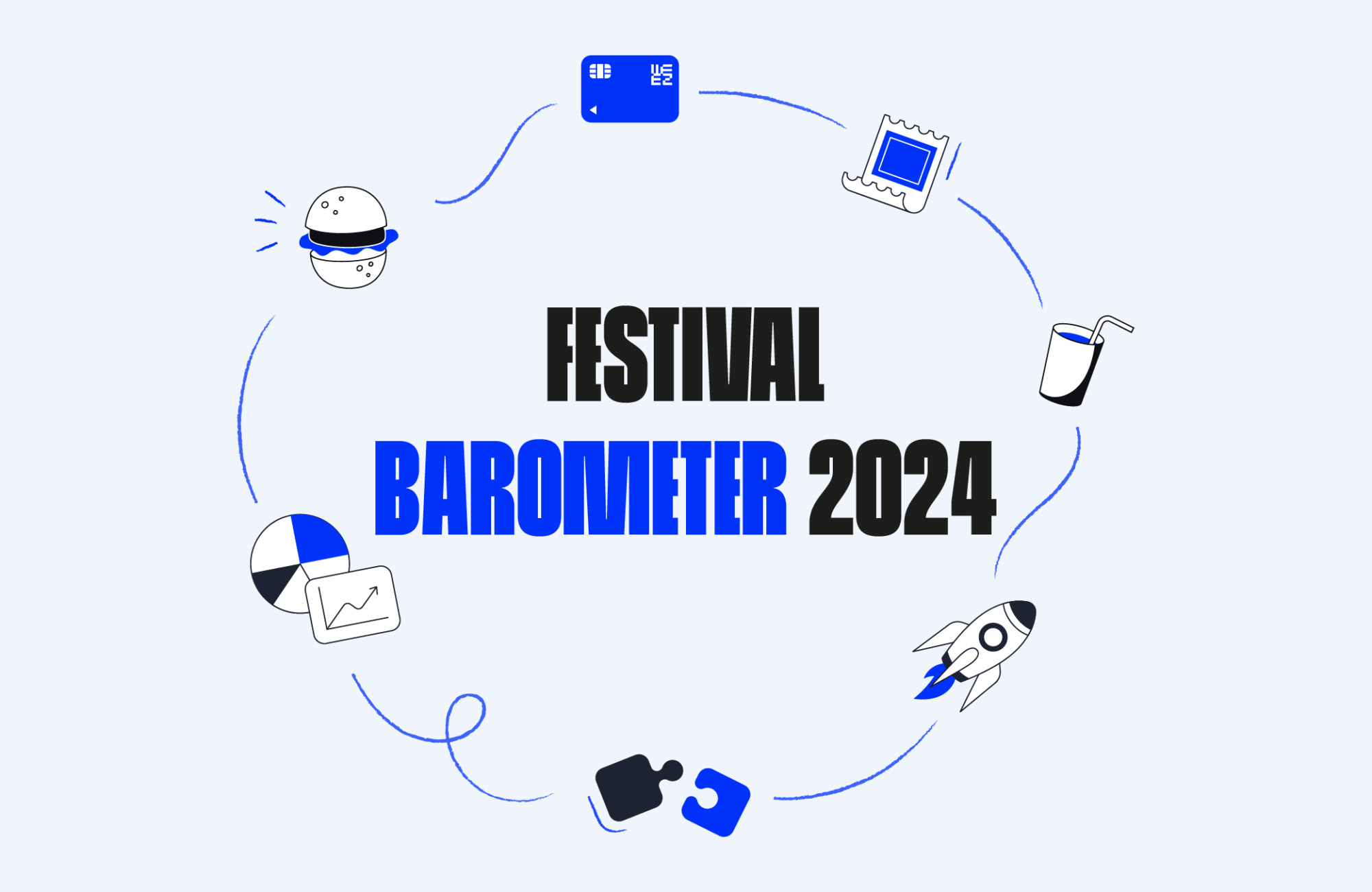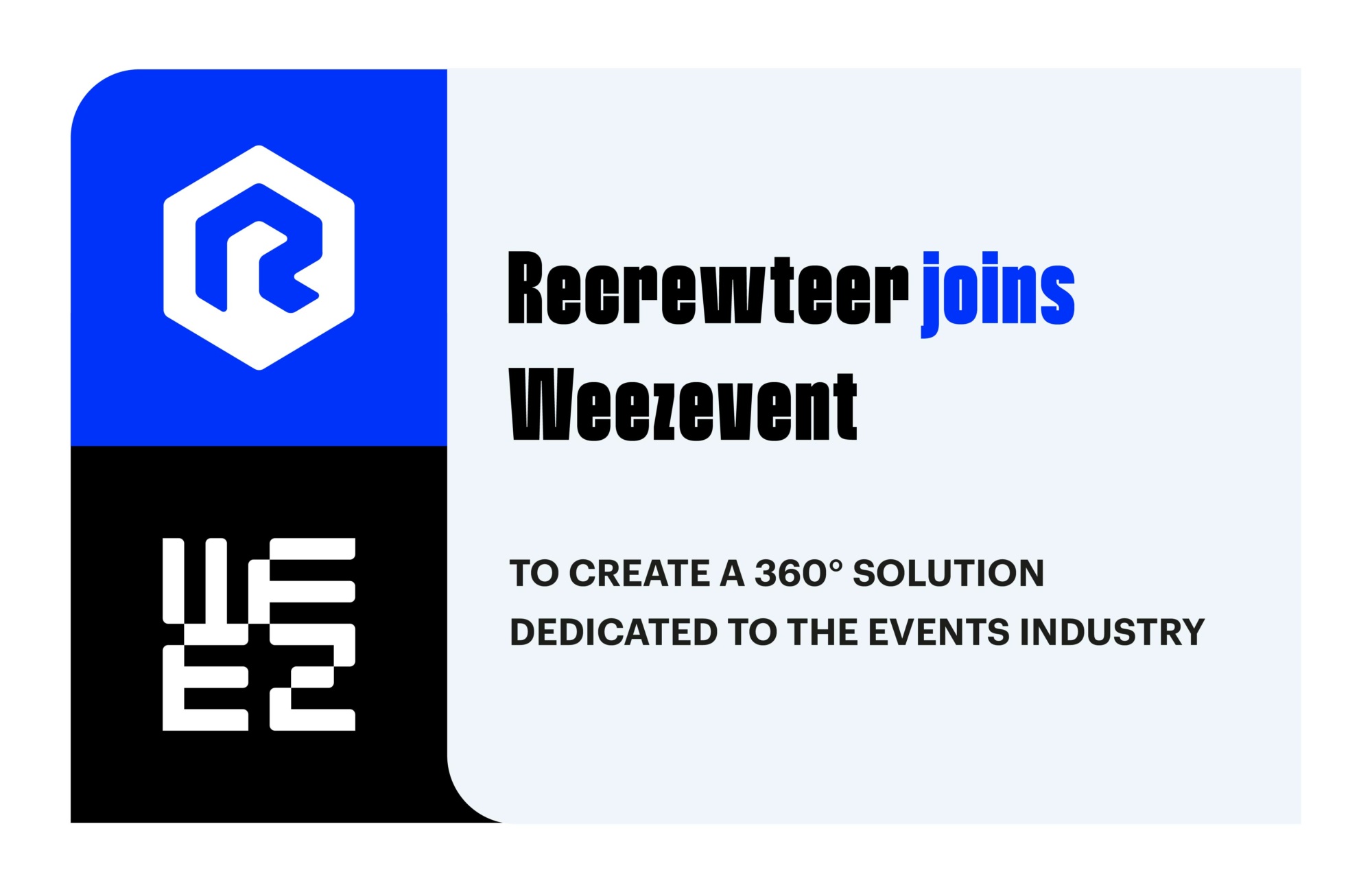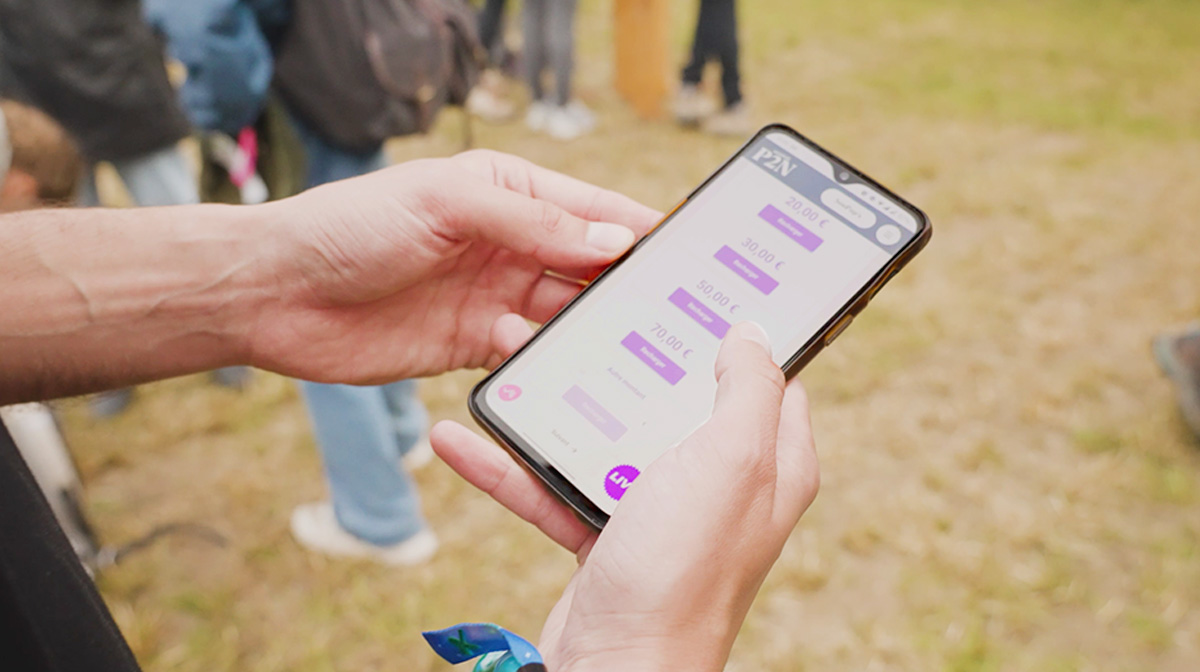Update 2024 : Want to explore the latest data? Check out the 2024 Festival Trends and Consumption Barometer. Go to the 2024 Barometer.
2023 marks an inflexion point for the European festival sector due to post-pandemic economic challenges, growing environmental issues and changing consumer habits.
This year was marked by significant inflation, leading to increased production costs, from artists’ fees to logistics costs, directly impacting pricing strategies. These changes have influenced festival attendance and highlighted adjustments in festivalgoers’ consumption patterns.
In this complex context, our report provides a detailed analysis of European festivals between 2022 and 2023, with figures. We explore fundamental aspects such as ticket pricing, trends in drink offers, the composition of the average basket, and festivalgoers’ relationship with the cashless system. These factors enable us to understand how the sector responds to these economic challenges, while highlighting emerging trends and strategies in a rapidly changing events environment.
Would you like to share the European results of the barometer?
Download the summary infographic
Summary
Scope of the barometer
In 2023, Weezevent worked with 590 large events in 19 countries, attracting over 14 million attendees. The year was marked by the growing adoption of cashless, both by organisers and attendees, with over 6 million cashless wristbands and cards distributed.
Our report presents a comparative analysis of the data collected for 2022 and 2023, from events in 9 European countries. This data was collected thanks to the suite of tools developed by Weezevent, including WeezPay for cashless payments, WeezTicket for ticketing, and WeezAccess for access control.
66% of the events analysed are considered large, welcoming more than 15,000 attendees daily. Most of these events (70%) took place in rural areas. The average duration of the festivals analysed was 3 days, although some lasted up to 10 days.
To ensure consistency and comparability of data, all currencies have been converted into euros, based on the average exchange rate observed from July 1st to August 31st. Prices are shown inclusive of all taxes.
Standard tickets, VIP tickets, self-distribution… what kind of ticketing strategy?
Festival ticket sales underwent significant changes in 2023. The average day ticket price in Europe has risen by 8%, going from €46.60 in 2022 to €50.50.
It should be noted that the average ticket price in 2023 varies significantly according to the size and type of festival, with variations of up to -19% (€41) for small festivals and +15% (58€) for urban festivals.
For attendees looking for a first-class experience, 37% of festivals offer premium tickets, including VIP access, sometimes with exclusive benefits. This strategy illustrates the organisers have identified a market segment willing to pay more for exclusive experiences. VIP tickets not only provide an additional source of revenue for organisers but also meet demand for personalised services and superior comfort.
Prices and consumption at the bars
Our study focuses on pricing and consumption at festival bars, focusing on beers, soft drinks and cocktails. We define standard beers as those most commonly sold and least expensive, and premium beers as those offered at a higher price because of their quality or uniqueness.
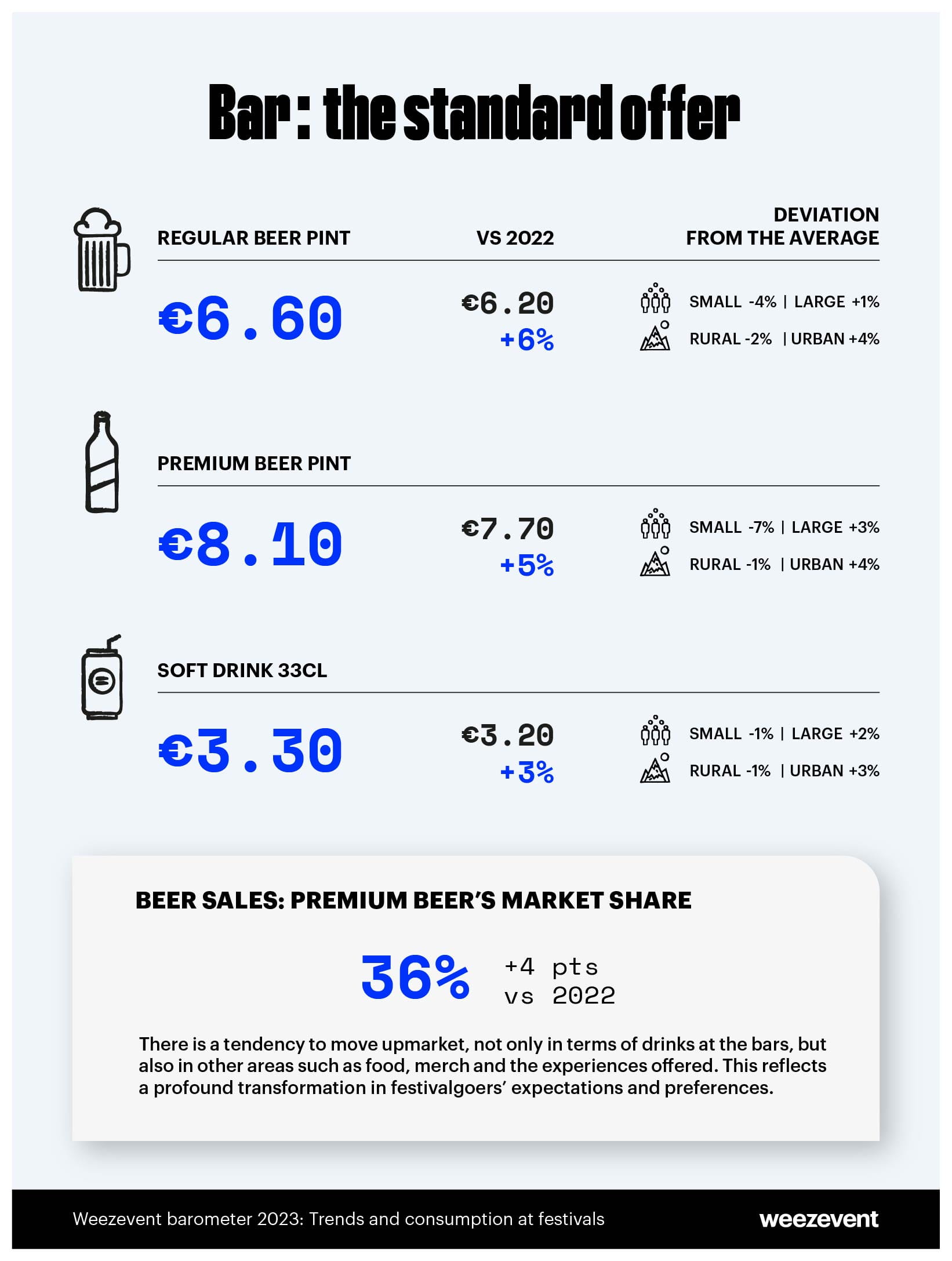
Regular & premium beers
The average price for a regular beer in Europe is €6.60, indicating an increase of 6% compared to 2022.
The price range for regular beer varies from €3.00 to €10.00. Prices are uniform, with a minimal difference of €0.39 between small and large festivals, the latter being the most expensive. Similarly, there is a difference of €0.45 between urban festivals, which are the most expensive, and those in rural areas.
The average price of a 50cl premium beer in Europe is €8.10. The trend between 2022 and 2023 follows the same pattern, with a 5% increase.
Premium beer accounts for 36% of total beer consumption, indicating a growing appeal for this type of offer, with an increase of 4 points compared to 2022.
Looking at the festivals offering both regular and premium beers, 19% recorded higher sales of premium beer than regular beer. This data illustrates the remarkable potential of the premium segment to attract a specific market, increase revenues and improve customer satisfaction.
Average beer consumption
At the same time, with the rise in the price of beer and inflation, the average consumption of beer per day per attendee has fallen by 7%, to 0.67 litres in 2023. It should be noted that the average consumption per attendee at small events is higher (0.86 litres) than at large events (0.66 litres). Average consumption remains relatively similar between urban and rural festivals, at 0.71 and 0.65 litres, respectively.
Non-alcoholic drinks
Across Europe, the average price of 33cl soft drinks is €3.30, an increase of 3% from last year, and varying considerably from €1.00 to €6.60. However, the type and size of the festival have very little influence on the price, with a slightly higher price for urban (+3%) festivals.
Bar sales trends
The move upmarket is confirmed at festival bars and extends beyond the increase in demand for premium beer. Cocktails win favour with festivalgoers; depending on the country and its regulations on alcohol sales, this goes from cocktails like Spritz to hard liquor.
Let’s take the example of a large-scale French festival in an urban environment: cocktails represented 12% of bar sales in 2022 and correspond to 19% of total bar sales in 2023.
At a large urban festival in Spain, we observed that the proportion of sales accounted for by hard liquor increased by 21% from one festival edition to the next (from 24% to 29% of total bar sales).
This shift in bar preferences illustrates a growing demand for more upmarket options, affecting not only drinks but also food, merchandising and the experiences on offer. This reflects a profound transformation in audience expectations and preferences.
Composition and evolution of the average basket
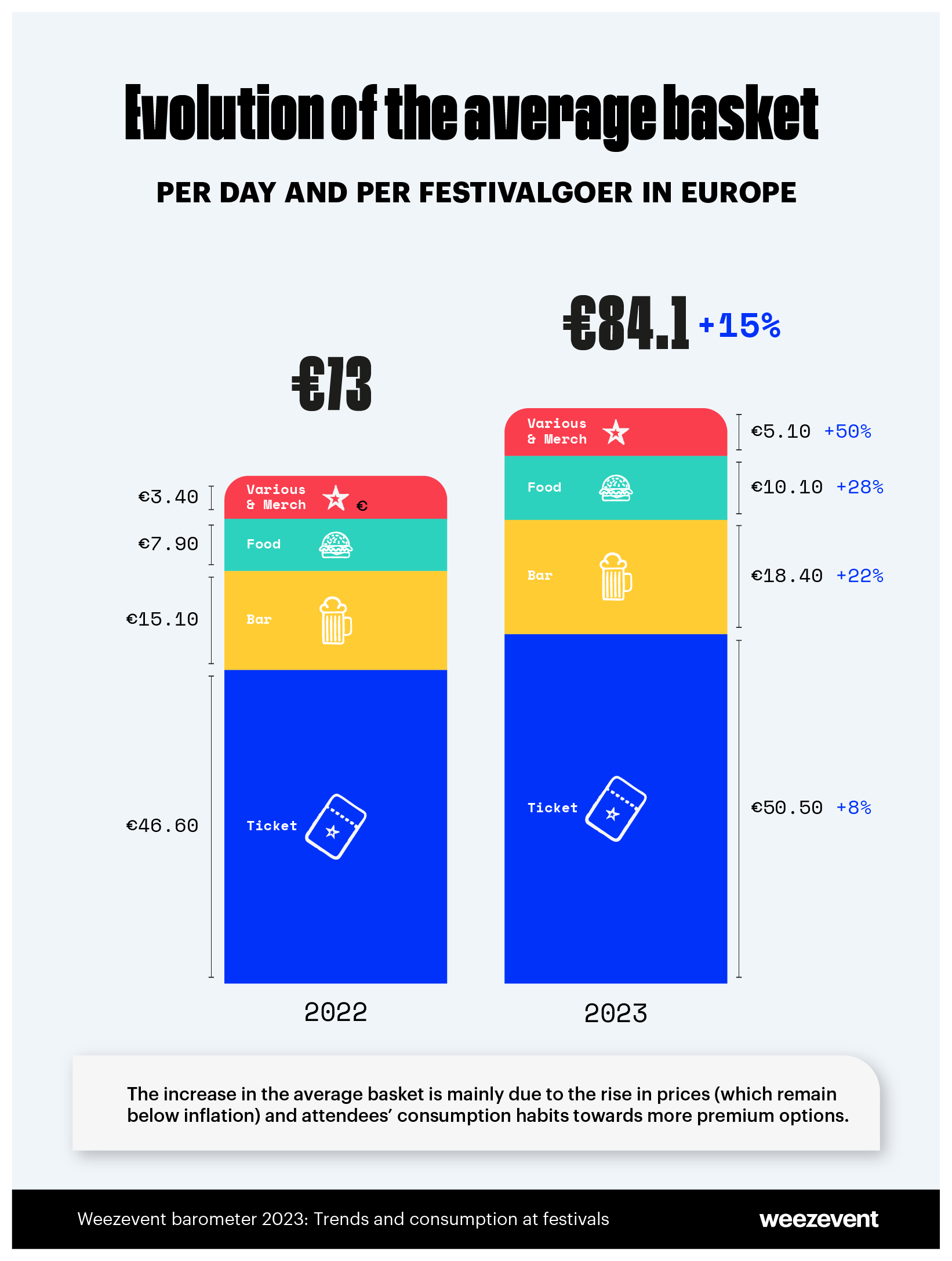
The average daily festivalgoer basket analysis is based on revenue from several sources, including ticket sales, bars, food and other activities (merchandising, eco-cups, ancillary activities, cashless activation or refund fees, etc.). This multi-dimensional analysis reveals significant trends in festivalgoers’ consumption habits.
The average daily basket per festivalgoer across Europe is €84.10, an overall increase of 15% compared to 2022. This increase breaks down as follows:
- Ticket prices: €50.50, up 8%
- Bar expenses: €18.40, up 22%
- Food: €10.10, up 28%,
- Various and merchandising: €5.10, up 50%.
The year 2023, with its unique economic challenges, underlines the importance for festival organisers to adapt their offer. Despite falling beer consumption, the significant increase in bar spending indicates a growing interest in more upmarket drinks.
This widespread trend points to an opportunity for innovation in the food & beverage offering, by including more premium products. In addition, the rise in merchandising and ancillary activities suggests a potential for expansion in these areas to increase revenues while enriching the overall festivalgoer experience.
Cashless payment practices
In this section, we explore festivalgoers’ preferences for topping up their cashless account. This information is essential for event organisers who want to adapt their payment options to changes in attendee habits.
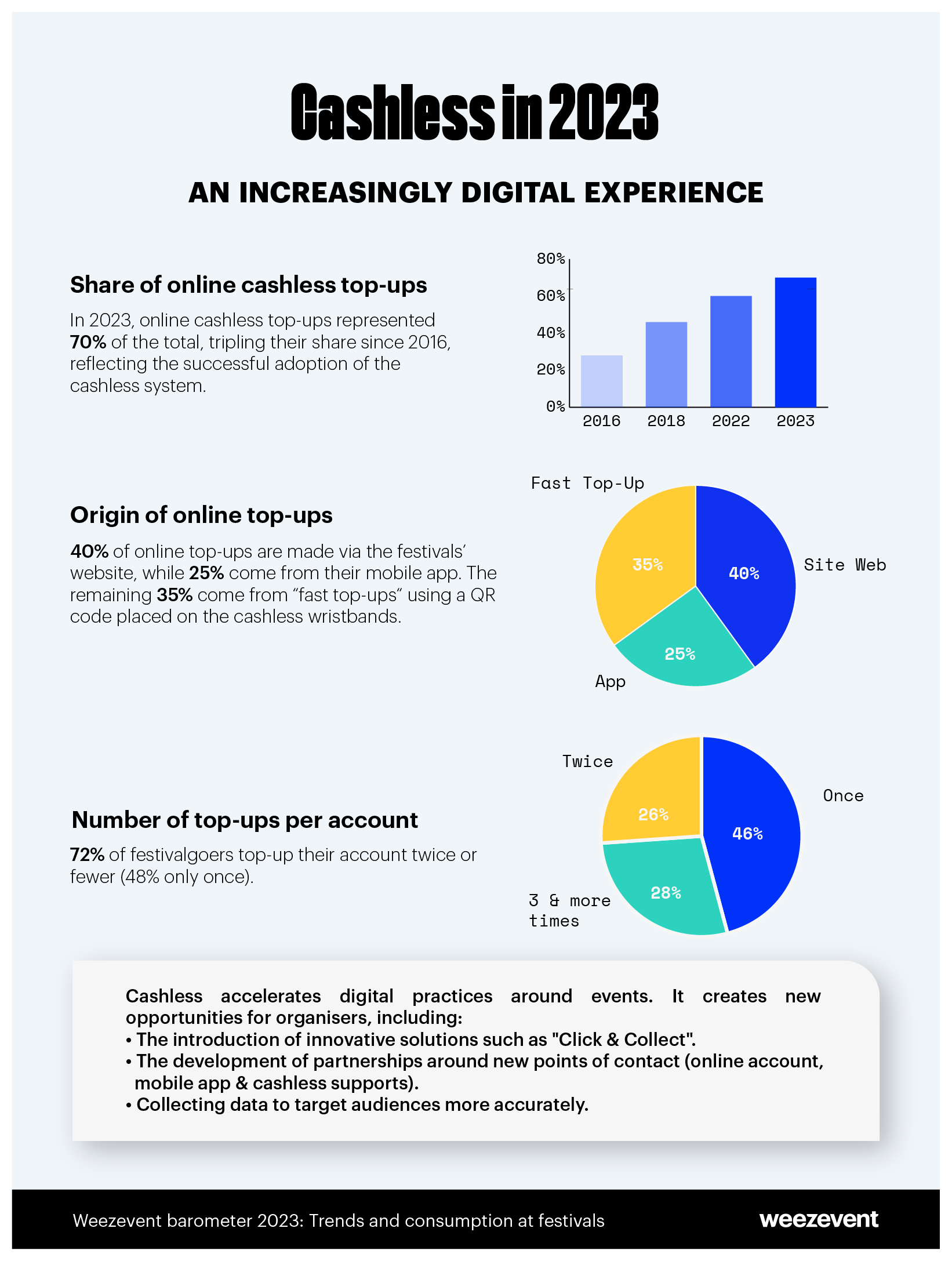
Online top-up predominates
For greater autonomy and less waiting at the top-up stations, festivalgoers increasingly choose to top-up their accounts online. In 2023, 70% of top-ups were made online. This increase of 10 points compared with 2022 indicates a rapid and growing adoption of this top-up method.
Of these online top-ups, 40% are made via the festivals’ website, while 25% come from their mobile app. The remaining 35% comes from fast top-up: using a QR code printed on the attendee’s wristband, a Weezevent innovation that combines autonomy and efficiency.
1 to 2 top-ups maximum per event
An analysis of the use of cashless accounts by festivalgoers in 2023 reveals some significant trends. Around 72% of attendees top-up their account twice or fewer times during the event, and almost half (46%) do so only once.
This moderate top-up frequency and a marked preference for online top-ups show that introducing cashless systems does not necessarily lead to queues at top-up stations. On the contrary, it suggests a smooth, optimised user experience.
The limited top-up frequency indicates that festivalgoers are inclined to top-up larger amounts to their accounts. This shows a high level of confidence in the security and reliability of the system, with attendees also able to obtain a refund of any unused balance after the festival.
Festivals’ environmental commitments
In the face of the climate emergency, it is imperative to adopt a collective approach to identifying, quantifying and minimising environmental impacts. With this in mind, Weezevent has already shared its carbon footprint report, which helps calculate the impact of our solutions on events. This report provides an overview of environmental commitments observed at festivals in 2023.
To reduce the impact of attendees’ travel, the main factor in an event’s emissions, 47% of the festivals surveyed have set up private shuttles, and 27% have partnered with a public transport service.
In addition, our results show that 34% of events are taking a proactive stance by partnering with carbon neutrality initiatives:
- The use of reusable water bottles.
- Waste collection and recycling.
- The installation of dry toilets.
- Eco-responsible communication (recycled or eco-labelled paper, vegetable-based inks).
- Food stalls offering local and plant-based products.
- Solar-powered sound and stage lighting systems.
- The installation of marine nets to retain waste in the water.
Conclusion
2023 marked a significant transformation in the European events sector, demonstrating strategic adaptation in an ever-changing environment.
Organisers have readjusted ticket prices in response to inflation, while festivalgoers have opted for more premium consumption, particularly regarding the drinks. This trend has contributed to a general increase in the average festivalgoer basket.
Cashless is a powerful driver of digitalisation for events, encouraging technological innovation and the adoption of new uses. It creates new opportunities for organisers, including:
- The introduction of innovative solutions such as “click & collect”, significantly improving the attendee experience.
- The development of new partnerships around new points of contact (online account, mobile app & cashless wristbands and cards).
- The ability to collect detailed data to target its audiences more precisely.
The festivals have demonstrated their environmental commitment, notably by offering eco-responsible transport and carbon-neutral initiatives. These efforts point to a promising trend, paving the way for broader collaboration within the events industry to generate a profound and lasting environmental impact.
To respond to these new trends and consumer habits, we advise event organisers to constantly adapt their offers and continue to enhance them (mobile app, premium drinks offer, environmental commitments, etc.).
It is important to note that these analyses are based on specific data and may not universally apply to all contexts or events. They should be a starting point for deeper understanding and informed decision-making.
Gathering and carefully analysing data from your own event enables you to assess the extent to which these results hold true for your specific audience. You can, for example, explore in detail the data collected on your Weezevent account through the ticketing, access control, cashless and e-mailing tools at your disposal.
Would you like advice on collecting and using your attendees’ data? Contact our team of experts!

